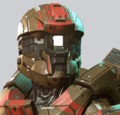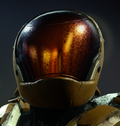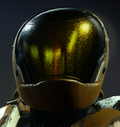Visual Intelligence System, Reconnaissance
From Halopedia, the Halo wiki
- "It's simple: If you see green, squad up. If you see red, shoot."
- — [1]
The Visual Intelligence System, Reconnaissance (VISR, pronounced "visor") is a proprietary integrated data management system used by UNSC personnel. It is incorporated into the helmets of Orbital Drop Shock Troopers and MJOLNIR GEN2, the latter of which features Version 4.0 of the suite.[2][3]
Overview
VISR provides tactical data in real time as it is broadcast. It can link into UEG, CAA, and UNSC infrastructure systems at the local, national, and global network levels, administered on a need or rating basis. The version of VISR issued to ODSTs near the end of the Human-Covenant War allows the user to store and review up to 610MB of content relevant to the current or all mission objectives.
Among other functions, VISR also provides navigational data and highlights various points of interest in the operational area. As of ODST BIOS update A29.817941B.01 it also features light enhancement systems, raising the brightness of the surrounding area on the user's heads-up display during low-light operations. VISR's low-light vision enhancement also links with the user's neural interface to provide Friend or Foe designation by searching for IFF transponders on friendly or enemy personnel. Enemy and friendly personnel and matériel are highlighted with different colors. Friendly combatants are highlighted in green whereas enemy combatants are highlighted in red. Usable weapons, vehicles, and medical kits are highlighted in blue; other objects and structures are highlighted in orange; beacons and data terminals are highlighted in yellow.[4]
VISR's core technology was originally developed for the MJOLNIR Powered Assault Armor[5] and was field tested by Spartan-III Headhunters.[6] Unlike the visual interface system developed for the Spartans, the ODST VISR requires no neural interface.[5] With the introduction of MJOLNIR [GEN2], the VISR 4.0 suite is now utilized by Spartan-IVs. This version is more similar to previous incarnations of the MJOLNIR heads-up display than the one used by ODSTs, and the new BIOS firmware allows a modification to the suite with the Z-5080 Promethean vision module. As of 2558 the highest version number is 4.09, though several customized types are available to operators within the Spartan branch's Specialization wings.[3]
VISR database
The VISR database holds pertinent and relative information concerning battle to provide a distinct tactical advantage to the wearer. The database encompasses three main parameters situated in a carousel formation:
- Navigation (NAV) - As an ODST lacks a motion trackers in his HUD, the NAV component in the VISR database provides a far more dynamic integration of mapping systems than featured by a standard motion tracker. It is very similar to the TACMAP in all MJOLNIR suits. The NAV tab is possibly the most useful feature in the VISR database suite because it provides a complete bird's-eye view of the current area in an interactive schematic grid; more importantly, the NAV parameter also shows the enemy forces in their entirety within the proximity of the highlighted area. This property of the database makes it very useful for tactical situations where planning is a key element. One downside to the enemy position interface is that the NAV function does not identify enemies individually (such as by rank or species) -- they are all represented with the same red diamond. However, one may still discern which types of Covenant infantry are in the vicinity by the marker's relative movement speed. Additionally, the NAV function only previews enemy locations within the vicinity of the VISR operator. User-set NAV markers may be displayed using this feature. The compass is synced with this parameter of the VISR database, as waypoints and beacons show up as integrated icons within the direction in relation to their location.
- Intelligence (INTEL) - This parameter is a comprehensive listing of the current mission objectives. On the right-hand side, a picture depicting the user is shown along with a symbol denoting rank, as well as the name of the operator. Another useful feature of this component is to set a marker to the current objective location along with a brief description of what the objective entails. Both the description and marker are broadcast upon the user's HUD. Beacons generally represent current objectives.
- Communications (COM) - This component is rather simplistic in its design and function.
There are other elements within the VISR database include the following:[7]
- Compass (integral with all factors regarding location, designation, and direction)
- Key locations (pre-placed beacons for mission objectives)
- Map legend (shown for all map elements)
- Grenade inventory (integrated with HUD)
- VISR database tabs (in carousel formation)
- Weapons and ammunition (integrated with HUD)
- Waypoint list
- Interactive local map
Known VISR Variants
This is a list of all GEN2 compatible Visor systems:[note 1]
| Visor color | |||
|---|---|---|---|
| Visor | Name/Version | Manufacturer | Information |

|
Standard VISR 4.0 - Recruit | Hannibal Weapon Systems | For all newly deployed SPARTAN-IV assets. This software manages the Spartan's disparate sensor feeds, battlenet links, and suit diagnostic messages. |

|
Improved VISR 4.02 - Solar | Materials Group | For flare mitigation and control operations. It also upgrades focus specifically on target acquisition speed, combat identification, and interoperability with UEG law enforcement networks. |

|
Improved VISR 4.03 - Cyan | Hannibal Weapon System | For protracted survival methodology. Too expensive to be universally deployed, this VISR hardware is protected against electromagnetic interference, shock and corrosive atmospheres. |

|
Upgraded VISR 4.04 - Blindside | Imbrium Machine Complex | For combat vindication reliance factor. This VISR is frowned upon by UNSC staff officers, and sacrifices strategic situational awareness for improved performance in small-unit actions. |

|
Upgraded VISR 4.05 - Frost | Lethbridge Industrial | For range visibility in subzero conditions. It has an integral climate module and multi-layer insulation that can function in extreme temperatures and exotic cryogenic atmospheres. |

|
Enhanced VISR 4.06 - Sunspot | Acheron Security | For fixed support and auxiliary efforts. With its integral climate module and multi-layer insulation the Frost VISR assembly can function in extreme temperatures and exotic cryogenics atmospheres. |

|
Improved VISR 4.07 - Verdant | Naphtali Contractor Corporation | For heavy machine operation in the field. It was updated to comply with the latest industrial cyberlink standards, as well as expanded support for legacy interfaces. |

|
Enhanced VISR 4.08 - Midnight | Materials Group | For spatial blackout during slipspace maneuvers. Materials Group uses this VISR as the basis for their next-generation battlespace management software, but proper use requires significant technical expertise. |

|
Maximized VISR 4.09 - Legendary | Materials Group | For next-gen asymmetric warfare operability. The Beta-5 Asymmetrical Action Group has adopted the Legendary VISR for their Spartan units, albeit with custom plugins developed by ONI's internal teams. |

|
Customized VISR 4.0 - Wetwork | Lethbridge Industrial | Optimized for WETWORK-class armor. |

|
Customized VISR 4.0 - Operator | Naphtali Contractor Corporation | Optimized for OPERATOR-class armor. |

|
Customized VISR 4.0 - Pioneer | Acheron Security | Optimized for PIONEER-class armor. |

|
Customized VISR 4.0 - Pathfinder | Imbrium Machine Complex | Optimized for PATHFINDER-class armor. |

|
Customized VISR 4.0 - Engineer | Manufacturer: Lethbridge Industrial |
Optimized for ENGINEER-class armor. |

|
Customized VISR 4.0 - Stalker | Naphtali Contractor Corporation |
Optimized for STALKER-class armor. |

|
Customized VISR 4.0 - Rogue | Hannibal Weapon System | Optimized for ROGUE-class armor. |
| Customized VISR 4.0 - Tracker | Acheron Security | Optimized for TRACKER-class armor. | |

|
Prototype VISR 5.0 | Hannibal Weapon System | The VANGUARD-class Mjolnir is field testing this VISR type.[8] |

|
Abyss | The galaxy is full of wonder and danger in equal measure. The Abyss VISR uses Subtle augmented reality tricks to reduce the Spartan's exposure to psychologically stressful visual stimuli, ensuring peak performance in even the most traumatic environments. | |

|
Armorer | A game changer for field operations, the Armorer VISR features its own augmented reality maintenance and diagnostic playbook that can walk Spartans through troubleshooting and basic repairs of most UNSC equipment. | |

|
Aureus | Containing dozens of useful functions for unaugmented users, the Aureus VISR is used by many new Spartans before they transition to more specialized HUDs. | |

|
Aurora | The designer of the Aurora VISR claimed it could see the unseen and visualize phenomenon outside of human comprehension. | |

|
Autumn | Unidentified AI | The Autumn VISR if a flawless example of software engineering and ergonomics. Approaching rampancy has inflamed its designer's auteur tendencies, resulting in a baroque design barely understandable even by other AIs. |

|
Beltane | The Beltane VISR can be easily monitored by an AI over the battlenet, allowing the operator to focus on difficult tasks without compromising situational awareness. | |

|
Buckingham | Unofficially tolerated, the Buckingham VISR is a privately developed data management suite sold only to active duty UNSC personnel. | |

|
Burgundian | It is not yours to understand why. Nor are you authorized to understand the subtle complexities and allure of the Burgundian VISR and its manifest menu options. | |

|
Clockwork | The Clockwork VISR is a piece of technical art, appreciated as a masterwork of programming and engineering by the handful of AI and human experts who understand the complexity of Mjolnir HUD design. | |

|
Connected | Developed by the avionics maintenance team aboard the Template:UNSCship, the Connected VISR's display elements can be replaced with only basic tools and minimal training. | |

|
Dauntless | Sangheili sourced high-tier nanolaminates and scanning elements make the Dauntless sensor grid and faceplate outrageously expensive even by Watershed Division standards. | |

|
Daybreak | The reflective coating on the Daybreak VISR is specifically designed to mitigate damage to sensitive optics in the case of viewing atmospheric nuclear detonations. | |

|
Dianthus | The Dianthus VISR kit was discovered by ONI operatives in the arms markets of Venezia. It's unclear who is manufacturing these VISR sensor elements or how widespread they have become. | |

|
Dusk | The first Dusk VISR was created in the resource-strapped final days of the Covenant War. Among its design goals were engineering refinements that drastically reduced the need for rare earths and other strategic metals. | |

|
Dynasty | The first VISR systems date back to the early 21st century, alternately bloating in complexity and paring down to bare-bones HUD management since then. The Dynasty HUD is an example of the former, with dozens of embedded quality of life apps. | |

|
Ecto | The pattern-matching subsystem of the Ecto VISR can be set to look for specific hyperspectral and multi-modal sensory traces, a useful function when tracking stealthy xenomorphs and transient electronic whispers. | |

|
Envy | Envy VISR's were developed by extreme sport enthusiasts on Mars. Through proven in environments far harsher than UNSC specifications required it took years to overcome anti-military sentiment in the boutique development house that made them. | |

|
Expedition | Built and ran through the harshest testing regime offered by the UNSC, the Expedition VISR can occasionally remain intact even if the rest of the helmet is destroyed around it. | |

|
False Dawn | Initial research and development for the False Dawn VISR promised an entirely new approach for head-up displays. Unfortunately, it will requires years of work on neural interfaces to make full use of the technology. | |

|
Flood | As the name implies, the Flood VISR is built specifically for Spartan assessment and containment teams deployed to Forerunner sites that may house samples of the all-devouring parasite. | |

|
Foucault | The Foucault VISR represents a major policy shift in the UEG towards allowing smaller corporations to compete in the paramilitary, military, and security markets. | |

|
Gallows | Made for special forward observation teams operating in quarantine zones, failsafe charges in the Gallows VISR will destroy the helmet (and everything in it) in case of compromise. | |

|
Glacier | Tested by hostile environment teams on a dozen frigid worlds, the Glacier VISR is the first choice for any Spartan expected to operate in cryogenic atmospheres. | |

|
Greystone | The Greystone VISR's unsettling advertising campaign featured Spartans standing on lifeless rocks at the edge of long-dead stars, staring into the void. | |

|
Ichor | The Ichor VISR's threat database is able to identify, index, and inform on all matters related to biohazards. | |

|
Independence | The Independence VISR was created by a team of UNSC maintenance personnel as a personal project. After the code was leaked to the net it has become the unofficial base for several independent HUDs. | |

|
King | The first King VISR was an enigmatic artifact produced as a one-off by a bored Huragok. Subsequent attempts to copy the design have been met with varying levels of failure.
| |

|
Mad Dog | Mad Dog VISR overlays lack even the most rudimentary image sanitation functions so that Spartan operators see only the rawest, most unadulterated view of the battlefield. | |

|
Matrix | Created for field technicians tasked with on-site cyberintrusion, the Matrix VISR has a custom built interface for managing networked AI's and friendly kill systems. | |

|
Mithral | Mithral VISR systems have been a staple of exploration teams that delve deep under the surface of resource-rich worlds. | |

|
Muse | Powered by the latest in polymorphic software agents, the Muse VISR may represent a breakthrough in semi-autonomous nonsapient assistants for Spartans. | |

|
Pendragon | Ruinously expensive, only a handful of private armies can afford the cutting-edge Pendragon VISR and associated software licenses. | |

|
Primeval | The Primeval VISR is a throwback design created after data archaeology efforts recovered novel branches of the first Mjolnir VISR codebase in burned-out Damascus Materials Testing Facility computer cores. | |

|
Rampant | Beweglichkeitsrüstungsysteme | With its proprietary set of software extensions, Beweglichkeitsrüstungsysteme hopes to position the Rampant VISR as the de facto standard for integrating with Forerunner sensor systems. |

|
Reflection | The Reflection VISR was created for pioneers delving into the welkin realms of slipspace, tapping into experimental sensors and probes to translate strange vibrations and trace energy patterns into some semblance of order. | |

|
Regnum | Feature creep, ruinous cost overruns, and accusations of corruption notwithstanding, the Regnum VISR features the best threat management subsystem on the market. | |

|
Remembrance | The protective outer coating of the Remembrance VISR is coated with materials recycled from glassed colonies. | |

|
Resolute | Open source records indicate the Resolute VISR is customized for integration with the Artemis threat analysis and tracking hardware. | |

|
Rex | The Rex VISR proved exceptionally capable of identifying optical associated with Jiralhanae active camouflage systems. Prototypes were used by UNSC Marines units to track down Brute holdouts on Earth and Tribute. | |

|
Rime | Rime VISR HUD's are fully compatible with all UNSC radar, ladar, and sonar imaging sensors. | |

|
Royal | The Royal VISR features a translation system and local database of hundreds of human languages, many of which are now thought extinct after the Covenant War. | |

|
Saturnine | The Saturnine VISR hardware is fully compatible with Sangheili combat harness power and data feeds, leading some to believe it's intended for export. | |

|
Scoundrel | The Scoundrel VISR was created for use by ONI field operatives but has since made its way to the criminal underworld and into Insurrection hands. | |

|
Secrets | ONI Section Zero's used their experience with managing complicated intelligence data networks to inform the Secrets VISR design and functionality. Unfortunately there is little doubt that secret backdoors were placed in the code. | |

|
Sluagh | A small percentage of SPARTAN-IV candidates experience augmentation defects. Those related to vision can usually be corrected with implants or custom HUD's such as the Sluagh VISR. | |

|
Starfire | Records siphoned from the Forerunner ship buried under the ice at Babd Catha informed the Starfire VISR architecture, but it will be decades before even a fraction of the site's archived secrets are decrypted. | |

|
Strife | When monomaniacal focus on a limited set of targets is needed, the Strife VISR can be fitted to augment existing predictive tracking capabilities. | |

|
Tenebrae | Tenebrae VISR systems are intended to be used in conjunction with imaging radar, ladar, and other systems that allow tactical operations to be conducted in the complete absence of visible light. | |

|
Torchbearer | Torchbearer VISR's are tailored for use by UNSC Army pathfinders. | |

|
Unbreakable | Built from the latest composites and reverse-engineered Covenant technology, the Unbreakable VISR can survive even when the surrounding helmet is torn asunder. | |

|
Vandal | Even when Spartans lose, the Vandal VISR ensures they do it with style and panache. | |

|
Vespertine | Leaked development documents for the Vespertine VISR's next firmware upgrade show superior augmented reality performance and interactivity. | |

|
Wild Hunt | Proven on the means streets of Earth's megaplexes, the Wild Hunt VISR has a custom optical recognition application used for decoding gang signs and other underworld symbology. | |
Trivia

|
Browse more images in this article's gallery page. |
- When VISR is activated, Huragok writings are highlighted on walls around New Mombasa. They appear to be Covenant or Forerunner symbols. They commonly appear around dead Sangheili.
- The navigational database system in the VISR is similar to the TACMAP in both SPI and MJOLNIR armor systems.
- Anything using active camouflage (specifically, Brute Stalkers) will be highlighted in orange by the VISR. This means that the system identifies cloaked objects as scenery.
Gallery
VISR mode in Halo: Helljumper.
VISR 4.0 used with the Promethean vision enhancement package.
VISR 4.0 utilized in Halo: Escalation.
List of appearances
- Halo: Helljumper (First appearance)
- Halo 3: ODST
- Halo: Evolutions - Essential Tales of the Halo Universe
- Halo 4
- Halo: Escalation
- Halo: Nightfall
Notes
- ^ To avoid unnecessary clutter caused by redundant citations, all subsequent entries are cited using the Halo 4 and Halo 5: Guardians Spartan Armor menus.
Sources
- ^ Bungie.net: "Feet First" Update
- ^ Halo 4 Official Site: Gameplay
- ^ a b Halo 4 - All 17 Visor Colors, Master Chief Helmet & Grifball!
- ^ Bungie.net: Halo 3: ODST Project Page
- ^ a b Halo Waypoint: VISR (defunct, backup on Archive.org)
- ^ Halo: Evolutions - Essential Tales of the Halo Universe, "Headhunters", page 164
- ^ UNSC Field Operations Guide (Halo 3: ODST Instruction Manual), page 8-9
- ^ Halo 4: The Essential Visual Guide - Page 167




